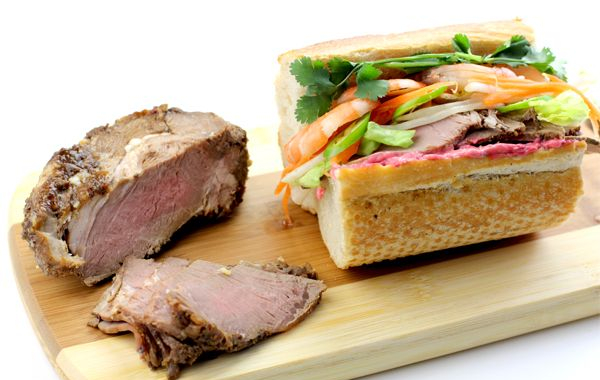We recently had roasted lamb flavored with pomegranate. As usual, I used the leftover meat the following day and prepared my favorite sandwich, a bánh mì of course!
I have to admit a lamb bánh mì is not “authentic”. Having said that, bánh mì is an adaptation of the French baguette sandwich. When the French left Vietnam, some of the ingredients such as the cornichons (French small gherkins) became so costly, they were substituted with local food items (pickled carrots and daikon with cilantro and sliced green chiles). The fillings can be tailored to suit your favorite flavorings. Adaptation and experimentation are why we have the foods we have today, so get in the kitchen and have some fun!
1. Info for Roasted Lamb Banh Mi Recipe
- Cook Time: 15 mins
- Total Time: 30 mins
- Servings: 4
- Calories: 418 kcal
2. Ingredients for Roasted Lamb Banh Mi Recipe
- 4 pounds boneless leg of lamb
- 2 tablespoons papaya paste (see tips)
- 1 teaspoon cayenne pepper
- 2 tablespoons kosher salt
- 1 tablespoon black pepper, coarsely ground
- 6 cloves garlic, finely minced and pureed
- 2 cloves garlic, unpeeled and halved lengthwise
- 3 tablespoons Dijon mustard
- 4 tablespoons pomegranate molasses
- 1 cup red wine
- 1 large pomegranate, juiced
- 1 tablespoon dried mint
- 1 tablespoon ground coriander
- 8 pre-boiled shrimp, peeled, deveined and cut in half lengthwise
- 2 cups lettuce, shredded
- 1 cup pickled carrot and daikon (find recipe in Banh Mi cookboook*)
- 1 baguette (find recipe in Banh Mi cookboook*), cut into quarters
- 1½ cups bean sprouts
- 8 sprigs fresh cilantro
3. Directions:
3.1 For the lamb marinade
Reserve a bit of the pomegranate juice to flavor the lime mayonnaise.
In a large bowl, combine the papaya paste, cayenne pepper, pomegranate molasses, pomegranate juice, wine, puréed garlic, mustard, mint, coriander and 6-7 tablespoons oil. Season with salt and black pepper. Stir well. Create small incisions all over the meat, fill them with the halved garlic and marinade and cover the meat with the remaining marinade. Marinate in the refrigerator for at least 10 hours or overnight (2 days are even better!).
3.2 Roasting lamb
Preheat the oven to 450°F.
Remove the meat from the refrigerator at least 30 minutes ahead of time to bring it back to room temperature before cooking. Tie the leg of lamb with twine (there are plenty of very informative Youtube videos on the matter) and secure the leg tightly with a knot.
Place the probe of a digital oven-proof thermometer in the center of the leg. Set the thermometer at 145°F (see tips), depending on how pink you like the meat. (Note: The IKEA brand thermometer has a magnet so I can stick it to the hood of my stove while searing the meat.)
With a brush, grease a Dutch oven with oil and heat until it’s really hot, almost to the smoking point. Pat dry the meat. Season with salt and pepper on one side. Using tongs, place the meat (seasoned side down) in the Dutch oven (still on high heat) and cook for 3 minutes. It’s important that you not pierce the meat once it’s seared, so it stays moist and tender. Season the top with salt and pepper. Flip the meat on the other side. Pan-sear for another 2 minutes. Remove the roasting pan from the stove and transfer to the pre-heated oven.
Roast the meat until you reach an internal temperature of 145-147°F, depending on how pink you like your meat. Using a silicone brush, baste the meat frequently with the marinade from the bottom of the Dutch oven. Note: It took 1 hour and 25 minutes for this piece.
Remove the meat from the oven. Cover with a piece of aluminum foil. Let the meat sit for an hour as the meat temperature will rise by a few degrees right after it’s transferred from the oven. Transfer to a cutting board. Sprinkle with salt. I didn’t re-heat the meat as it’s better at room temperature for the sandwich. That way the meat stays very juicy and tender.
3.3 Assembly
Slice the lamb into ¼” thick pieces, fanning the slices for a nice presentation.
Flavor the lime mayonnaise with a drizzle of pomegranate juice until it become a rosy pink color.
Remove the inside of the bread. Drizzle the inside with pink mayonnaise. Spread a thin layer of butter in both sides of the bread.
Fill the sandwich with sliced lamb, bean sprouts and pickled carrots and daikon. Add the shrimp and sliced jalapeño pepper. Garnish with 2 sprigs of cilantro. Close the sandwich tightly.
Bon appétit!
4. Tips and advices:
- I use green papaya as a meat tenderizer to ensure moist and juicy meat. The papaya paste was Baji, my husband Lulu’s late grandma’s secret for tender and moist meat. Peel a green papaya. Grind the cubed papaya with seeds in a mini food processor; place about 2 tablespoons of papaya paste per slot in an ice-cube tray and freeze them. Transfer the ice-cubes into sealable plastic bags and place back in the freezer.
- I buy pomegranate molasses in a local Persian market.
- The roasting time depends on how pink you like the lamb. If you want to be absolutely sure (and that’s my fool-proof way of cooking lamb), just place a temperature probe in the center of the piece of meat, and remove the lamb from the oven when the thermometer registers at least 135°F (I prefer 145°F, so the meat is less rosy). You can get a digital thermometer at IKEA for a reasonable price.
- Make sure to let the lamb shoulder rest before slicing it to ensure optimum tenderness of the meat.
- Quick reminder on how to prepare the Vietnamese pickles: Peel the carrots and daikon and shred them. If you use a shredding vegetable peeler, you’ll get long threads of carrot and daikon pieces. Cut into about 3″ pieces. You could also slice the vegetables with a mandoline, then julienne them using a sharp knife, but I wouldn’t recommend using a grater blade on a food processor as the vegetables will become a bit soggy and mushy. Place the carrots, daikon and 1 sliced jalapeño pepper in a bowl. Sprinkle with sugar. Drizzle with rice vinegar and lime juice. Toss well. Let sit for about 15 minutes. Mix well. Drain the vegetables, reserving as much liquid as possible.
- Little reminder on how to boil the shrimp: Combine 1 quart water, a bit of sugar, rice vinegar, cooking wine, thin ginger slices, red chili powder and caramelized onions in a small saucepan. Bring to a boil. Dip the shrimp into the liquid (once it’s changed colors) for about 2-3 minutes. Add salt. Check doneness of the shrimp; it should be firm, white with shades of orange. Drain the cooked shrimp. Once it’s cool enough to handle, carefully shell (make sure to remove the tip of the tail as well, this part is very delicate) and de-vein the black part of the shrimp using a sharp hook-like paring knife, then cut in half lengthwise.

